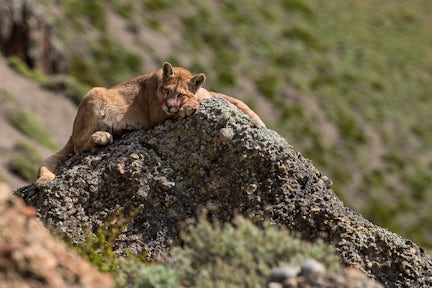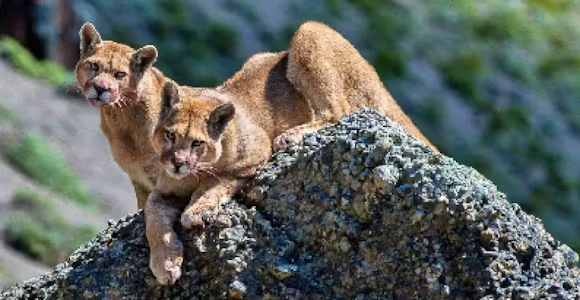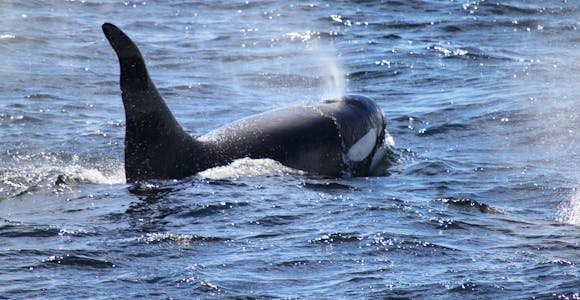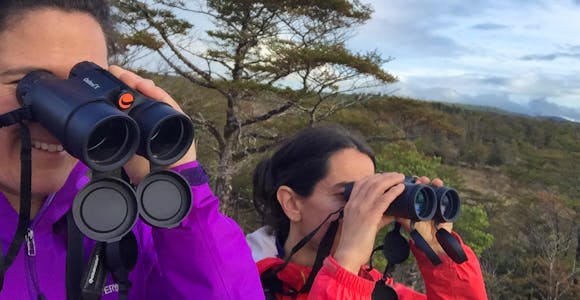Andean Puma
This beautiful big cat is the largest predator in Patagonia and the southern-most dweller of all its relatives. The Chilean government made puma hunting illegal in 1980, and numbers have since increased. Pumas take full advantage of the varied terrain in Torres del Paine and are able to live in the cold, warmth, forest & mountains. They are most often seen at dusk and dawn when out hunting for one of their favourite dishes…guanacos! Our dedicated puma tracking experts know these areas like the back of their hands, and give you the very best chances of observing pumas in their natural habitat.

A puma rests in Torres del Paine
Camelids
Guanacos
There are believed to be over 1,500 of this member of the llama species in Torres del Paine National Park alone. They live in herds for protection and to rear their young. They’re very energetic animals who run around chasing one another, and mothers are fiercely protective of their young so it’s best not to get too close!

Vicuna
Vicuna have pale cinnamon fur on their bodies with a white belly and a long tuft of white hair on their chest. They have a long neck, thin legs and a slender build. Small family groups stay in the male’s territory during the day and retire to higher slopes at sunset to sleep. They graze on grasses and must drink daily, a factor that limits where they can go. They are very shy animals and will let out a high warning whistle before fleeing danger. They are graceful runners and can attain speeds of 29 miles per hour at high elevations due to their heart being double the size of similar-sized mammals.

Deer
Huemul Deer
These endangered deers has short legs & a stocky build, enabling them to live on rocky terrain & climb mountain passes with ease. They are one of the most elusive animals in Patagonia & became a Chilean National Natural Monument in 2006. Despite this status, they are currently under threat from changes in their natural habitat, and predation by the puma. Your best chance of spotting one is on a hike in Torres del Paine, particularly in the vicinity of Lago Grey and off-the-beaten-track areas like the Silencio Valley. Patagonia Park in Aysen is another great location for spotting them.
Pudu Deer
The Southern pudu is the world’s smallest deer. These deers form small, monogamous family groups and raise one young at a time. The female will make a soft ‘moo’ call to her young whilst the male has a goat-like bleat. It is said that when the pudu is alarmed, the hairs rise, the body trembles and the eyes fill with tears (in reality, the lacrimal glands open). Pudu’s feed on fruit, nuts and twigs. Their natural predators include pumas, kodkods and darwin’s foxes. Although protected they are hunted for their hide and meat.

Small animals
Armadillo
Hairy Armadillo
Hairy armadillos have long hair between their plates. They are nocturnal in summer and sometimes hibernate in the winter but if not, come out in the daytime. They dig deep burrows to live in and feed on insects, maggots and plant roots. They are said to kill snakes by jumping on them and using the edge of their carapace to cut them. They are hunted as a pest, and for their meat and shell.
Pichi or Dwarf Armadillo
Dwarf armadillos have a dark brown shell with a yellow edge. They live in shallow burrows in open areas at the base of small bushes on sandy soils. They are solitary animals, nocturnal, and hibernate in winter. They feed on insects, worms, small rodents and lizards. They are sometimes kept as house pets but are also hunted for their meat and shell.

Magellanic Tuco tuco
Tuco tucos dig long tunnels in the Patagonian pampas where they feed on plant roots and bulbs. When hammering and drumming can be heard from these tunnels it’s a good clue for locating a colony. The tuco tuco was an important food source for the Ona tribe of Tierra del Fuego. Nowadays, sheep ranching on the pampas has led to the disappearance of many tuco tuco colonies.

Mountain Viscacha
Mountain viscachas have long hairy tails which they hold in a semi-curled position whilst resting and fully extend when moving. They are diurnal and spend most of the day sunbathing on rocks, or dust-bathing. Viscachas live in colonies in boulder strewn areas of the Andes and like to shelter in rock crevices. They eat plant matter and require little or no water for drinking. Natural predators include foxes and cats. Although they are protected in Chile, illegal hunting has dramatically reduced their numbers in central and southern regions.

Degu
Degus live in colonies in sclerophyll woodland. They dig communal tunnels which have multiple entries hidden by bushes and low trees. The tunnels have separate communal areas for nesting, storing food for winter and a toilet area. Degus communicate to each other in high pitched whistles and growling noises. Their long tail is easily shed – if a predator grabs it, the skin and fur will strip off, leaving bare bone. The bone withers, falls off and does not regrow.

Coypu
Coypus are Chile’s largest native rodent. Their skin appears cinnamon-coloured all over and the tip of their muzzle and chin are white. These creatures are mostly nocturnal and feed on aquatic vegetation supplemented with crustaceans and garden crops. They nest in burrows at the edge of marshes, river banks or estuaries. Coypus are protected in the national parks of Chile as their velvety underfur is highly valued in the fur trade.

Mara
Maras look like giant rabbits but they are in actual fact large rodents. They are monogamous and up to 22 pairs will live together in communal dens. During breeding season the den becomes a creche – the young are raised together, with one set of parents guarding the den for an hour at a time whilst the other parents are away.

Lesser Grison
Lesser grisons have very elongated bodies and short legs. They are quick and agile climbers and good swimmers. They are mainly active at night and live under tree roots, rocks or burrows made by other animals. They have a sharp, growling bark when alarmed. They can dig family galleries up to four metres long. They feed on small mammals, birds eggs, plants and fruit.

Hog-nosed Skunk
Hog nosed skunks are solitary except during the spring breeding season. They are nocturnal and are mostly active at twilight. They feed on roots, spiders, small birds, crabs, fruit and small mammals. Skunks can be found in grassy areas at woodland edges.

Foxes
Culpeo fox
Culpeo is said to stem from the Mapuche word culpem, meaning madness because of how boldly this fox reveals itself to hunters. These foxes are solitary except when breeding when the pair will dig deep dens.
South American Grey Fox
The South American grey fox has a long, bushy tail with a black tip. They feed on rodents, birds, lizards, frogs, insects and fruit. They are a protected species in Chile but are illegally hunted by livestock farmers.
Darwin’s fox
This short-legged fox hunts at night, feeding on insects, small mammals, birds and berries. Formally known only from a specimen collected by Charles Darwin in 1833 but rediscovered in 1922.

Cats
Geoffroy’s Cat
Named after the French naturalist Geoffroy St. Hilaire, these felines look like small, slender, domestic cats. They vary in colour from spotted silvery-grey to ochre or all black. These cats are nocturnal and hunt on the ground or in trees, feeding on birds, rats, guinea pigs and other rodents. They have a litter of two to three each year. They were once heavily exploited for the fur trade but now protected in most South American countries.

Kodkod
The smallest wild cat in the Americas, kodkod’s have a stocky body, dark brown fur and yellowish lines on their head and shoulders. They live in trees and make their dens out of bamboo, constructing a hammock like nest of interwind branches, lined with belly hairs. Kodkods feed on rabbits, rodents and birds. They are known to raid rural henhouses, killing several chickens but eating only the brains.

Andean Mountain Cat
Andean mountain cats have thick ashy grey fur with yellowish-brown irregular blotches and a long, heavy tail with six to nine dark brown or reddish rings. They are most active at dusk and dawn and feed on chinchillas, viscachas, tuco-tucos, birds and reptiles. They are hunted locally for their pelt and for use as a religious icon.

Photos (C) Rodrigo Tapia (C) Bernabe Urtubey

Chloe O’Keeffe says
Every time I return to Patagonia I spot different animals, there is so much to be discovered in addition to the ‘big three’ and having a dedicated guide allows you to spot things that the untrained eye would never have noticed!
More Patagonian Wildlife…

Torres del Paine is home to a growing population of the elusive puma. We work with responsible guides to give you great wildlife experiences while protecting the animals’ habitat.
Discover More

Join a dedicated whale-watching cruise or boat trip with specialist guides to protected fjords and bays in either Chile or Argentina to observe Patagonia’s whale up close.
Discover More

Patagonia is an incredible place to see penguins (‘Pinguinos’ in Spanish), and there is a surprising variety of species too! You’ll find penguin reserves throughout Patagonia, …
Discover More

Patagonia is home to over 460 species of birds, making a trip to Chile or Argentina an unforgettable experience for any birder. From the famous and dominating Andean Condor …
Discover More
Impartial advice and a bespoke service to make your trip perfect.
We are former guides, tour leaders, outdoor enthusiasts & adventurers.
Swoop is proud to be B Corp Certified as we know sustainability is more than our carbon footprint (but we’re reducing that too).
We’ll make sure you have the adventure of a lifetime.
Perched on the shores of the vast blue Nahuel Huapi Lake, the alpine town of San Carlos de Bariloche is surrounded by stunning forests, mountains, and lakes as far as the eye can see in the Argentinian Lake District.
DISCOVER MORE
Ready to plan your Patagonia adventure?
Listen
We’ll spend some time listening to your aspirations, then discuss the kind of experience that might suit you.
Match
Next we’ll discuss the options, shortlist the best trips for you and present you our impartial recommendations.
Reserve
We’ll place a 24 hour hold on your preferred option – without obligation – whilst we talk through the details.











